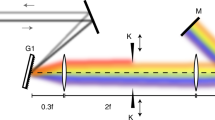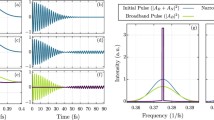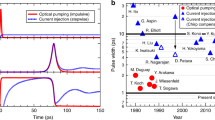Abstract
We obtain white light continuum pulses with durations as short as 80 fsec. The broad spectral range (0.19μ–1.6μ) minimal chirp, stable repetitive character, and availability of powers extending to the gigawatt range suggest these pulses will provide a powerful new tool for femtosecond spectroscopy. We obtain these pulses by using short (65 fsec) pulses from our colliding pulse mode locked laser [1] which have been amplified to gigawatt powers in an amplifier designed specifically for short pulse amplification [2]. The short duration and high intensity of these amplified pulses permit us to generate continuum pulses in a short length of nonlinear medium with the consequence that pulse distortion by group velocity dispersion is minimal. We thus generate pulses which are temporally short and which also have almost negligible chirp over broad spectral regions. Such a feature is essential for femtosecond time resolution in most practical applications. This approach is also of special interest in that the temporal distribution of the continuum is determined primarily by the generation mechanism rather than by group velocity dispersion in the generating or analyzing media. We can thus present convincing evidence, e.g., that self phase modulation plays a prominent role in the continuum generation process.
Access this chapter
Tax calculation will be finalised at checkout
Purchases are for personal use only
Preview
Unable to display preview. Download preview PDF.
Similar content being viewed by others
References
R. L. Fork, B. I Greene, and C. V. Shank, Appl. Phys. Lett. 38, 671 (1981).
R. L. Fork, C. V. Shank, and R. T. Yen, Appl. Phys. Lett. 41, 273 (1982).
C. V. Shank, R. T. Yen, R. L. Fork, J. Orenstein, and G. L. Baker, to be published.
L. F. Mollenauer, R. H. Stolen, and J. P. Gordon, Phys. Rev. Lett. 45, 1095 (1980).
Author information
Authors and Affiliations
Editor information
Editors and Affiliations
Rights and permissions
Copyright information
© 1982 Springer-Verlag Berlin Heidelberg
About this paper
Cite this paper
Fork, R.L., Shank, C.V., Yen, R.T., Hirlimann, C., Tomlinson, W.J. (1982). Femtosecond Continuum Generation. In: Eisenthal, K.B., Hochstrasser, R.M., Kaiser, W., Laubereau, A. (eds) Picosecond Phenomena III. Springer Series in Chemical Physics, vol 23. Springer, Berlin, Heidelberg. https://doi.org/10.1007/978-3-642-87864-0_3
Download citation
DOI: https://doi.org/10.1007/978-3-642-87864-0_3
Publisher Name: Springer, Berlin, Heidelberg
Print ISBN: 978-3-642-87866-4
Online ISBN: 978-3-642-87864-0
eBook Packages: Springer Book Archive




